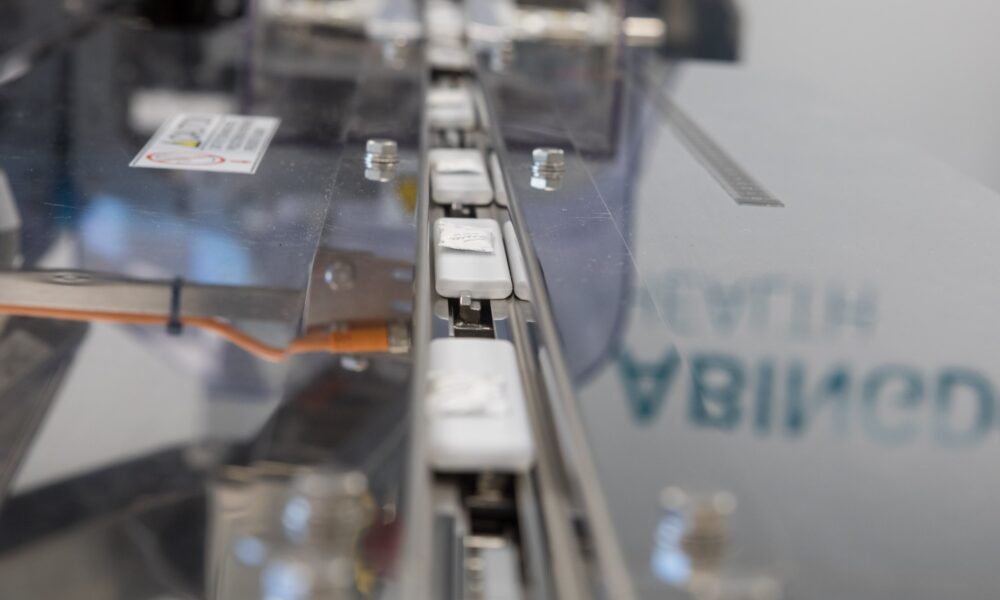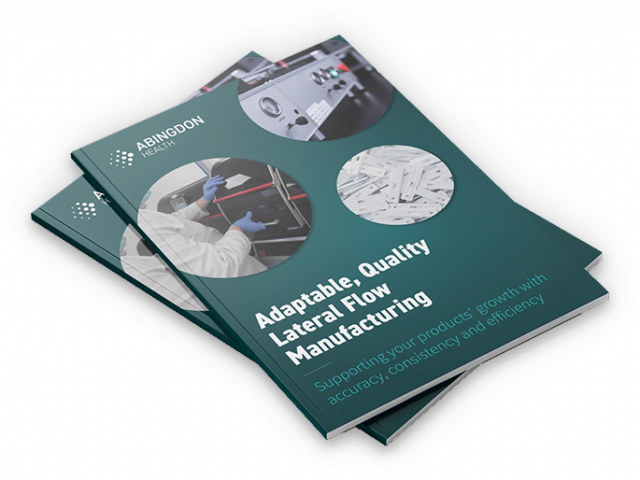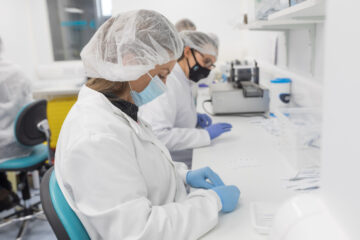Manufacturing Lateral Flow Tests: ”A Sprint And A Marathon!”

Lateral Flow Manufacture: An Overview
“Keep It Simple Stupid”
QC: A Key Component
The Right Balance Of Automation
Continuous Improvement: It’s About Walking The Walk
Risk Management and Disaster Recovery Planning
Key Take-Away
In this article, our Operations Lead, Jess Aird, discusses Abingdon Health’s approach to lateral flow test manufacture, operational readiness, and resilience.
Lateral Flow Manufacture: An Overview
Lateral flow manufacture can be complicated and can involve several steps, for example:
- reagent manufacture
- spraying of reagents on nitrocellulose
- lamination with backing card, sample pads, wicking pads, and other materials
- cutting of cards into strips
- housing strips in plastic housings
- foiling these devices along with desiccant; and ultimately
- final kit packing with all components
Each step of the process requires detailed evaluation and Abingdon Health’s approach is to consider the manufacturing process as a critical element of any development and scale-up plan. But importantly the “sprint to manufacture” is very much the start of this process and the manufacturing process will continue to be evaluated, reviewed, and improved upon during the manufacturing stage. In that way it’s very much a long-term value-creation opportunity, and yes, it’s marathon as well as a sprint!
“Keep it Simple Stupid”
No. We are not being rude. There is a reason for the rather abrupt subtitle! “Keep it Simple Stupid” is thought to have been coined by Kelly Johnson, who was the lead engineer at the Lockheed Skunk Work”1, which developed the S-71 Blackbird spy plane amongst other things. Kelly wasn’t wrong and one of Abingdon Health’s key manufacturing challenges is to keep our customers’ manufacturing processes simple. Why? Because it reduces risk and makes the process more robust.
One of the key considerations we apply to the lateral flow manufacturing processes is to reduce where possible the complexity of each step in the manufacturing line and ensure the step is scalable both in the short, medium, and long-term. Abingdon Health’s approach is to work closely with our customers to iron-out any complexities during the development and scale-up stages so that the manufacturing process is not subjective and is repeatable batch-in, batch-out.
QC: A Key Component
This is very much a holistic approach. For example, one area which can often be overlooked is the quality control (QC) methodology being applied during the manufacturing process. We take considerable care and attention to ensure the QC process established during development and implemented during technical transfer and manufacturing stages is straightforward, robust, repeatable, statistically appropriate, and ultimately meets the requirements of the finished product in customers’ hands. Selecting the right QC panel, properly characterized, and adopting an appropriate QC methodology, in terms of when testing is performed and how much testing is undertaken, can save a significant amount of time and money during the manufacturing process.
The Right Balance of Automation: During The Manufacturing Journey…
 There are many moving parts in lateral flow manufacturing and there’s a ‘sweet spot’ of combining the right personnel with state-of-art the art facilities and processes that deliver tests consistently on-time and in-full (OTIF). This is product specific.
There are many moving parts in lateral flow manufacturing and there’s a ‘sweet spot’ of combining the right personnel with state-of-art the art facilities and processes that deliver tests consistently on-time and in-full (OTIF). This is product specific.
For example, if the initial requirement is for low volume batch sizes this will most likely start with a higher element of manual manufacturing, as it may be the most cost-effective solution.
However, it is important to ensure that the product is “fit for automation” as ultimately if volumes grow and there is a higher level of manufacturing required it is important the product will be ready for transition to more automated solutions over time. This is part of Abingdon Health’s development process and ensures the potential for effective transition from manual to automated solutions in time. In this way we see the manufacturing process as a journey and importantly dynamic. Our focus is very much on developing for manual and automated manufacturing.
As part of our evaluation, we also pro-actively consider bespoke automated solutions to meet our customer’s needs. Abingdon Health works closely with both our customer and our automated manufacturing equipment providers to consider cost-effective bespoke solutions where required. This can also apply to key components. One good example is tooling for plastic housing. Surety of supply of this key component is critical and we work closely with tooling companies to create moulds that meet specific customer needs. Creating your own mould can be cost-effective and offers a greater level of control over the quality of the components being produced.
Continuous Improvement: It’s About Walking The Walk
Over time manufacturing processes can always be improved and simplified. These can be generic changes, for example in the emergence of new automated manufacturing instrumentation which can reduce manual intervention and improve cost-effectiveness. Significant research and development have gone into this area in recent years, driven in part by the impact on the lateral flow market from COVID-19. Therefore, we are seeing improved automation coming on line as well as greater opportunity to integrate existing automated equipment, which can improve efficiency.
Improvements can also be specific to a particular product; and this is driven by a culture of continuous learning and understanding of the product during the manufacturing phase. For example, this can be as simple as changing the spray rates on spraying machines to improve product performance and increase the speed of the manufacturing process, saving time and money. We very much see our role as our customer’s partners for the long-term, supporting product improvement and ultimately improving their customers’ experience.
Risk Management and Disaster Recovery Planning: It’s Not Box Ticking!
 Risk management covers a range of activities. For example, supply chain management has been a major challenge during the past couple of years. Ensuring security of supply of key components remains a major consideration. Abingdon Health’s dedicated supply chain team supports its customers from the outset of a project through to ongoing manufacture to reduce this risk. We’ll discuss supply chain solutions in more detail in an upcoming article. Register your email to get the article direct to your inbox.
Risk management covers a range of activities. For example, supply chain management has been a major challenge during the past couple of years. Ensuring security of supply of key components remains a major consideration. Abingdon Health’s dedicated supply chain team supports its customers from the outset of a project through to ongoing manufacture to reduce this risk. We’ll discuss supply chain solutions in more detail in an upcoming article. Register your email to get the article direct to your inbox.
Also, robust disaster recovery planning is critical. Abingdon Health has access to two manufacturing sites, relatively close-by to allow staff to work across both sites. This means if there are any issues or spikes in demand both sites can pool resources and overcome the problems across the two sites.
The Key Take-Away
Lateral flow contract manufacturing: it’s a partnership; and it’s a marathon and a sprint!
Abingdon Health’s key objective is to ensure robust, reliable, and efficient manufacturing of our customers’ products. Manufacturing robustness is a key element of this and as set out above several factors feed into this from the simplicity of the manufacturing process, the level of automation and the risk management activities undertaken.
All these actions are dynamic, it starts during the development phase, but Abingdon’s role is to ensure that we manage our customers’ products throughout its manufacturing journey, to improve efficiency, reduce cost and manage risk. It’s very much a partnership for the long-term!




